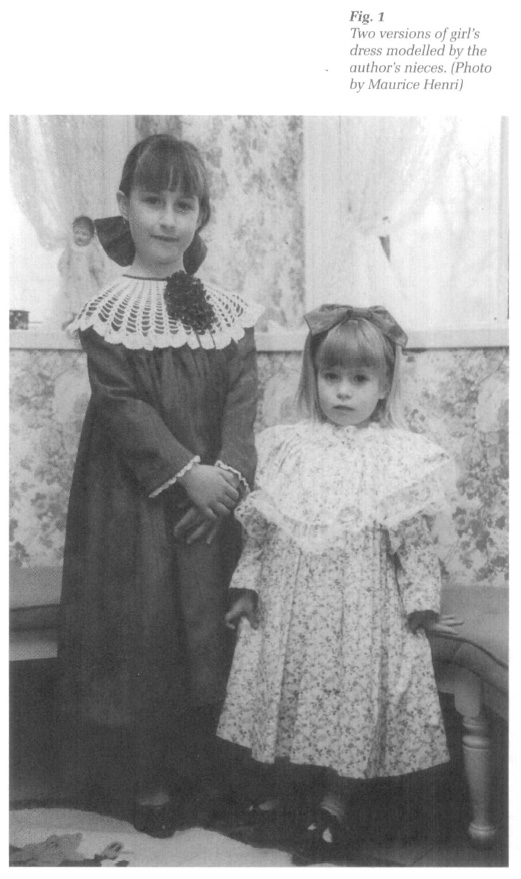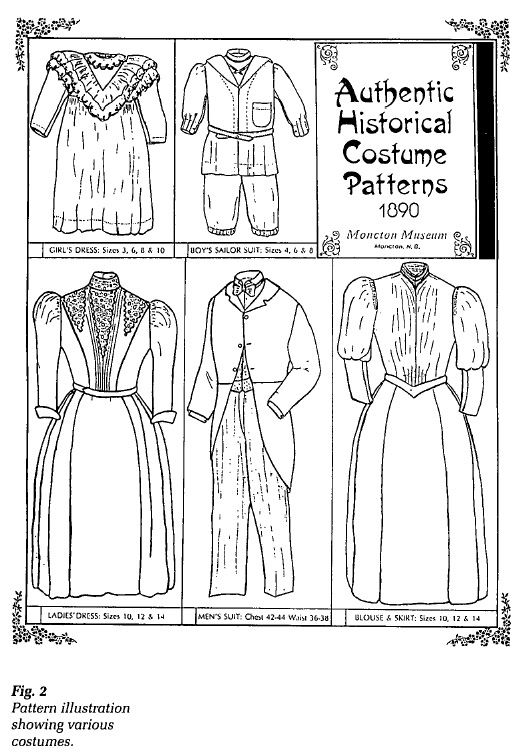Research Reports / Rapports de recherche
Authentic Historical Costume Patterns from the Moncton Museum
1 To help celebrate Moncton's 100th anniversary in 1990, the Moncton Museum hired me to research and design a series of patterns. By providing good representation of local, late Victorian styles, this project helped Monctonians sew accurate costumes for parades, balls and other local events.
2 The patterns have become a long-term fundraiser for the Museum and are available to museums and shops in Canada and the United States. In 1991, the American Association for State and Local History awarded a Certificate of Commendation to the Moncton Museum in honour of its activities during the centennial, mentioning especially the historical patterns.
3 My report explains the project's objectives and outlines my methodology.
4 Producing full-size patterns from authentic garments for Moncton's centennial in 1990 proved to be an undertaking that required careful consideration. Initially, certain criteria were established for selecting the appropriate garments:
- Local costumes were considered first.
- Preference was given to garments made and worn in the Moncton area.
- The style of the garment had to be representative of the time period.
- Garments had to be suitable for reproduction and allow for easy modification.
- Simplicity and straightforwardness of construction were other considerations.
Using these criteria the following outfits were chosen.
Ladies' Costumes
5 Two ladies' costumes from the Moncton Museum's collection were documented as having been worn in the local area. The original black-figured satin blouse was worn by Mrs. James Neales Wathen. Representing everyday fashion, it was no doubt made at home, and was subsequently greatly altered. It was ultimately made of 29 pieces, but the original pattern would have only required 13 pieces. Such additional piecing in the late-nineteenth century was very common. It required cleverness on the part of the dressmaker to conceal the seams, and cutting the garment consequently became a much more difficult task than it would be today. The black skirt was worn by Mrs. Mary Ann Steeves. It was made in many panels with the fullness drawn at the back, as was typical for the period. The two-piece brown outfit with cream lace was worn by Mrs. Sarah T. Harrison for "going out," shopping or walking. The particular construction of this gown adapted itself well to small changes, so as to create a variety of dresses that might be appropriate for a particular occasion.
Girl's Dress
6 The little girl's dress, reportedly worn in the Dorchester area, was located in the Keillor House Museum's collection. It was very well suited for the project because of its versatility; simple alterations could produce a variety of dresses similar to examples seen in local photographs of the time. Also, the particular cut of the dress was suitable for reproduction in many types of fabric, from velvet to cottons prints (Fig. 1).
Boy's Sailor Suit
7 Museum collections tend to have fewer boy's garments in their collections than girl's clothes. The original sailor suit from the New Brunswick Museum's collection was first worn in Chatham, N.B. at the end of the nineteenth century and well represents a style popular before 1890. It bears a commercial label inside that reads "The Regatta Suit."
Gentlemen's Attire
8 The morning coat from the Université de Moncton's Musée acadien was worn by Mr. Robert Saulnier at his wedding and soon after in the conduct of his general merchandise business in Harcourt, N.B. The label inside indicates that it was custom-made by E. C. Cole Ltd. of Moncton. Compatible trousers selected from the Moncton Museum's collection were worn by Mr. J. H. Harris. The buttons marked "E. C. Cole, Moncton, N.B." show that the trousers were made by the same tailors as the coat. An advertisement in the Moncton Daily Times in 1890 stated, "Mr. E. C. Cole's clothing house is one of the most extensive in the maritime provinces and is exclusively devoted to men's and boy's clothing. Mr. Cole employs 30 to 35 hands in the custom tailoring ..." The original trousers were all hand finished and would have been specifically tailored for Mr. Harris. His name and size are inscribed in ink on the inside pocket. The waistcoat, also from the Moncton Museum, was worn by Mr. John Humphrey Steeves, a shoemaker who lived in Moncton at the time.
9 Several different steps were followed to ensure that an accurate pattern could be taken from the original garments. First, the original was measured thoroughly and all information recorded. Then, each piece of the garment was measured from a centre line determined from the warp thread. All angles that could be measured were recorded. An outline of each pattern piece was traced onto a plastic sheet by piercing gently through the plastic with a pin all along the seam lines. The fullness of the gathers or the depth of the darts was measured and accounted for while pinning the plastic sheet accordingly. Sleeves and other shaped pieces were stuffed lightly to facilitate the task. At this point the pattern was taken without allowing for seams. The direction of the grain of the fabric was indicated as well. Sometimes it was easier to work with the garment inside out. After this preliminary work was done, the outlines were transferred onto a dark background of tissue paper. The work was then set up on a cutting table and drafting began. The measurements, recorded before the actual tracing of the pattern, were compared at this point, and appropriate corrections were made to take into account piecing and alterations that had occurred over the years, damaged or torn areas, and even possible shrinkage caused by incautious laundering.
10 Sizing was done by using a standardized chart. Each and every pattern piece was enlarged according to the exact measurements specified on the chart. It must be noted, however, that each original garment was tailored specifically for one particular person and consequently did not necessarily correspond to a standard size. The various sizes offered in the packages are thus in relation to the original garments, rather than to theoretical standards.
 Display large image of Figure 1
Display large image of Figure 111 An important factor at this time period, which considerably influenced the final outcome of the cut of a particular costume, was the undergarments. The corset styles worn at that period tended to push up the rib cage while moving the shoulders back and the shoulder blades together, while at the same time holding the chin up. Garments were routinely cut to compensate for this. Today's dressmakers must make adjustments if the garment is to be worn without appropriate undergarments. The elegant high-standing collars of this era can become most unattractive if allowed to droop because of improper support. Sleeves may need to be reset forward, and the back on bodices will more than likely need to be cut wider to compensate for the absence of a corset.
12 Once the drafting was done the master copies for each size were hand inked with a reproducible India ink on tracing paper. The pattern pieces were specially arranged in order to fit the paper size selected for printing.
13 Each pattern package contains information on appropriate accessories and undergarments, hairstyles, fabrics and trims, and on the appropriate way to wear such costumes. As a final touch, illustrations showing the construction of the selected costumes and of each garment were also included (Fig. 2).
14 Full pattern details concerning the costumes can be received from: The Moncton Museum, 20 Mountain Road, Moncton, New Brunswick, E1C 2J8. Telephone: 506-856-4383; Fax: 506-856-4355.
